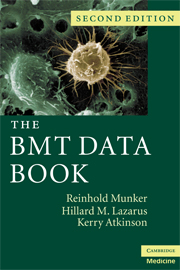Book contents
- Frontmatter
- Contents
- List of contributors
- Foreword
- Preface
- Acknowledgments
- Section 1 Basic science
- Section 2 Hematologic malignancies
- Section 3 Solid tumors
- 11 Therapeutic decision making in stem cell transplantation for breast cancer
- 12 Therapeutic decision making in BMT/SCT for nonseminomatous germ cell tumor of testis (NSGCT)
- 13 Therapeutic decision making in BMT/SCT for renal cell cancer
- 14 Therapeutic decision making in BMT/SCT for soft tissue sarcomas
- Section 4 Nonmalignant disorders
- Section 5 Practical aspects and procedures
- Section 6 Complications
- Section 7 The BMT/SCT pharmacopoeia
- Section 8 HLA-testing and laboratory medicine
- Appendix
- Index
- References
11 - Therapeutic decision making in stem cell transplantation for breast cancer
Published online by Cambridge University Press: 31 July 2009
- Frontmatter
- Contents
- List of contributors
- Foreword
- Preface
- Acknowledgments
- Section 1 Basic science
- Section 2 Hematologic malignancies
- Section 3 Solid tumors
- 11 Therapeutic decision making in stem cell transplantation for breast cancer
- 12 Therapeutic decision making in BMT/SCT for nonseminomatous germ cell tumor of testis (NSGCT)
- 13 Therapeutic decision making in BMT/SCT for renal cell cancer
- 14 Therapeutic decision making in BMT/SCT for soft tissue sarcomas
- Section 4 Nonmalignant disorders
- Section 5 Practical aspects and procedures
- Section 6 Complications
- Section 7 The BMT/SCT pharmacopoeia
- Section 8 HLA-testing and laboratory medicine
- Appendix
- Index
- References
Summary
The standard of care in the treatment of breast cancer and current recommendations for the diagnosis and treatment of breast cancer can be found in oncology textbooks and the guidelines from the National Comprehensive Cancer Network (www.nccn.org). Because breast cancers are generally sensitive to chemotherapy, it would seem logical that high-dose chemotherapy with stem cell support for metastatic disease would lead to higher remission rates and more durable remissions than those achieved by standard chemotherapy regimens and, in addition, might provide a potential for cure. After the initial optimism and promising findings from pilot and phase II studies, randomized studies were performed to compare high-dose chemotherapy with stem cell support and standard chemotherapy. Now, more than 15 years after the initiation of these studies, little evidence remains to support a role for autologous stem cell transplantation in the treatment of metastatic breast cancer (Vogl et al., 2006). In a 2005 Cochrane review in which six trials comparing high-dose chemotherapy with standard-dose chemotherapy for metastatic breast cancer were analyzed (Farquhar et al., 2005), no statistically significant difference was found in overall survival between the two groups at 1 year, 3 years, or 5 years of follow-up. However, a significant difference in event-free survival, favoring the high-dose group, was found at 1 and 5 years of follow-up. As expected, the toxicity of the treatment was significant in the high-dose chemotherapy group (mainly infections).
- Type
- Chapter
- Information
- The BMT Data Book , pp. 165 - 168Publisher: Cambridge University PressPrint publication year: 2009



